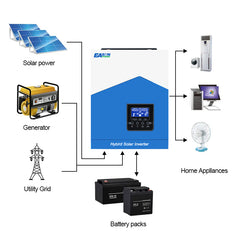Unlock the Power of the Sun: Discover the Ultimate Solar Inverter That Will Transform Your Energy Game!
As the world shifts towards sustainable energy, solar power has emerged as a key player in reducing our dependence on fossil fuels. With the increasing importance of harnessing renewable energy, solar inverters have become crucial components in solar energy systems. A solar inverter serves as the heart of a solar panel setup, converting the direct current (DC) produced by solar panels into alternating current (AC) that can be used to power your home or business. Among various options available, a 3000W solar inverter stands out due to its ideal balance of power capacity and efficiency, making it a popular choice for both residential and small commercial applications. In this article, we will delve deeper into the benefits of a 3000W solar inverter and what makes it a worthy investment for your energy needs.

Understanding Solar Inverters
To appreciate the value of a 3000W solar inverter, it's important to understand the different types of solar inverters and their functions. Primarily, there are three types: string inverters, microinverters, and power optimizers. String inverters connect multiple solar panels in a series, making them a cost-effective option for larger installations. Microinverters, however, are attached to each panel, allowing for maximum energy production, especially in shaded areas. Power optimizers work similarly to microinverters but are used in conjunction with a string inverter. Regardless of the type, inverter efficiency plays a critical role in maximizing solar energy conversion. A high-efficiency inverter ensures that more sunlight is transformed into usable energy, which is vital for enhancing your system's overall performance.
Why Choose a 3000W Solar Inverter?
The decision to invest in a 3000W solar inverter comes with numerous advantages, particularly for homeowners and small business owners. This inverter size is typically capable of powering essential household appliances, including refrigerators, televisions, and lighting. It provides ample capacity for small businesses that require a reliable power source without overloading the system. A 3000W inverter also boasts impressive efficiency rates, ensuring that you harness as much energy as possible from your solar panels. Additionally, its versatility allows it to be employed in various applications, whether you’re looking to power a single home or a small office, making it an ideal choice for those seeking to optimize their energy consumption.
Key Features to Look For
When considering a 3000W solar inverter, certain features can significantly impact your investment. Start by examining the efficiency ratings; look for inverters with at least 90% efficiency to ensure that most of the energy generated is converted for use. Compatibility with your existing solar panels is also crucial; check if the inverter can handle the voltage and current output of your panels. Durability is another key factor; a robust inverter can withstand various environmental conditions, ensuring longevity and reliability. Finally, consider the warranty options offered; a longer warranty period can provide peace of mind that your investment is protected against potential issues.
Installation and Maintenance Tips
The installation process for a solar inverter can vary based on your specific setup and local regulations. It’s recommended to hire a professional installer to ensure safety and compliance with electrical codes. A qualified technician will mount the inverter in a shaded location to avoid overheating and connect it appropriately to your solar panels and electrical system. Once installed, regular maintenance is key to ensuring optimal performance. This includes routine checks for dust accumulation or damage, ensuring that connections are secure, and monitoring performance metrics to catch any potential issues early on. Proper maintenance can extend the lifespan of your inverter and maximize its efficiency.
Cost and Energy Savings
While the initial investment in a 3000W solar inverter may seem significant, the long-term savings on energy bills can make it a worthwhile expenditure. By generating your own electricity, you can reduce or even eliminate your monthly energy costs, leading to substantial savings over time. Furthermore, solar inverters contribute to energy independence; as energy prices continue to rise, having your own power source can shield you from market fluctuations. Investing in solar technology also promotes sustainability, aligning with eco-friendly practices that benefit the planet. Many users find that the savings on energy bills and the potential incentives for renewable energy adoption often offset the upfront costs, making the transition to solar power financially advantageous.
Final Thoughts on Investing in Solar Inverters
In conclusion, investing in a 3000W solar inverter is a smart choice for enhancing energy efficiency, sustainability, and financial savings. With its ability to power essential appliances and small businesses, combined with its ease of installation and maintenance, this inverter type offers a robust solution for anyone looking to harness solar energy. By carefully considering the key features, installation tips, and long-term benefits discussed, you can make an informed decision that meets your specific energy needs. Embrace the power of the sun and take a step towards a more sustainable future today!


